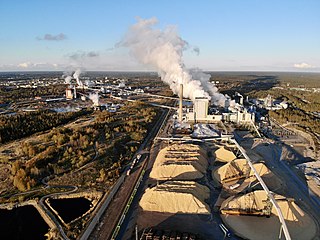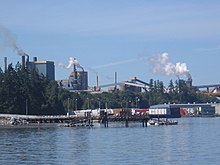
Pulp is a fibrous lignocellulosic material prepared by chemically, semi-chemically or mechanically producing cellulosic fibers from wood, fiber crops, waste paper, or rags. Mixed with water and other chemicals or plant-based additives, pulp is the major raw material used in papermaking and the industrial production of other paper products.

Domtar Corporation is a North American pulp and paper company that manufactures and markets wood fiber-based pulp and paper products. The company operates pulp mills and paper mills in Windsor, Quebec; Dryden, Ontario; Kamloops, British Columbia; Ashdown, Arkansas; Hawesville, Kentucky; Plymouth, North Carolina; Marlboro County, South Carolina; and Kingsport, Tennessee. While Domtar operated independently for several decades and was listed on the Toronto and New York stock exchanges, the company was acquired by Paper Excellence Group in November 2021 and has since operated as a subsidiary.
Norske Skog ASA, formerly Norske Skogindustrier ASA, which translates as Norwegian Forest Industries, is a Norwegian pulp and paper company established in 1962. The company has long been one of the world's leading manufacturers of newsprint and magazine paper. Due to a declining market for publication paper, the company has increasingly focused on other uses of timber and recycled paper, such as packaging. The company is headquartered in Norway and has factories in five countries and an annual production of approximately 2 million tonnes of paper (2020).

The kraft process (also known as kraft pulping or sulfate process) is a process for conversion of wood into wood pulp, which consists of almost pure cellulose fibres, the main component of paper. The kraft process involves treatment of wood chips with a hot mixture of water, sodium hydroxide (NaOH), and sodium sulfide (Na2S), known as white liquor, that breaks the bonds that link lignin, hemicellulose, and cellulose. The technology entails several steps, both mechanical and chemical. It is the dominant method for producing paper. In some situations, the process has been controversial because kraft plants can release odorous products and in some situations produce substantial liquid wastes.

The recycling of paper is the process by which waste paper is turned into new paper products. It has a number of important benefits: It saves waste paper from occupying homes of people and producing methane as it breaks down. Because paper fibre contains carbon, recycling keeps the carbon locked up for longer and out of the atmosphere. Around two-thirds of all paper products in the US are now recovered and recycled, although it does not all become new paper. After repeated processing the fibres become too short for the production of new paper, which is why virgin fibre is frequently added to the pulp recipe.

A pulp mill is a manufacturing facility that converts wood chips or other plant fiber sources into a thick fiber board which can be shipped to a paper mill for further processing. Pulp can be manufactured using mechanical, semi-chemical, or fully chemical methods. The finished product may be either bleached or non-bleached, depending on the customer requirements.

In industrial chemistry, black liquor is the by-product from the kraft process when digesting pulpwood into paper pulp removing lignin, hemicelluloses and other extractives from the wood to free the cellulose fibers.

Catalyst Paper Corporation is a pulp and paper company based in Richmond, British Columbia. It operates five pulp mills and paper mills, producing a combined 1.8 million tonnes of paper and 491,000 tonnes of market pulp annually. The mills mostly produce magazine paper and newsprint.
The Sartell Paper Mill, officially the Verso Paper Sartell Mill, was a paper mill located in the city of Sartell in the U.S. state of Minnesota, operating from 1905 until a disastrous explosion in 2012.
Norske Skog Skogn AS is a pulp mill and paper mill situated in Levanger, Norway, which produces newsprint. Situated on the Fiborgtangen peninsula in Skogn, the mill has three paper machines with a total annual capacity of 600,000 tonnes. Pulp is produced both from virgin fibers at an on-site thermomechanical pulp (TMP) mill and from recycled paper at a deinking (DIP) mill. Part of Norske Skog, it is the sole remaining newsprint mill in Norway.
Norske Skog Saugbrugs AS is a pulp mill and paper mill located in Halden, Norway, which produces supercalender (SC) magazine paper. Located in the river Tista in Tistedalen, the mill produces 550,000 tonnes per year in three paper machines. Pulp is produced both from virgin fibers at an on-site thermomechanical pulp (TMP) mill. Part of Norske Skog, it is the sole remaining magazine mill in Norway.
Bleaching of wood pulp is the chemical processing of wood pulp to lighten its color and whiten the pulp. The primary product of wood pulp is paper, for which whiteness is an important characteristic. These processes and chemistry are also applicable to the bleaching of non-wood pulps, such as those made from bamboo or kenaf.

Paper is a thin sheet material produced by mechanically or chemically processing cellulose fibres derived from wood, rags, grasses, or other vegetable sources in water, draining the water through a fine mesh leaving the fibre evenly distributed on the surface, followed by pressing and drying. Although paper was originally made in single sheets by hand, almost all is now made on large machines—some making reels 10 metres wide, running at 2,000 metres per minute and up to 600,000 tonnes a year. It is a versatile material with many uses, including printing, painting, graphics, signage, design, packaging, decorating, writing, and cleaning. It may also be used as filter paper, wallpaper, book endpaper, conservation paper, laminated worktops, toilet tissue, currency, and security paper, or in a number of industrial and construction processes.
The Tasman Mill site is a pulp and paper mill located on Fletcher Avenue just outside the town of Kawerau in New Zealand. The Tasman Mill site is the largest single employer in the Eastern Bay of Plenty region. Three pulp or paper companies previously operated in Kawerau: Norske Skog operated the mechanical pulp mill and newsprint paper mill; Oji Fibre Solutions, formerly Carter Holt Harvey, operated the kraft pulp mill; and SCA who manufacture tissue and base paper.

The environmental effects of paper are significant, which has led to changes in industry and behaviour at both business and personal levels. With the use of modern technology such as the printing press and the highly mechanized harvesting of wood, disposable paper became a relatively cheap commodity, which led to a high level of consumption and waste. The rise in global environmental issues such as air and water pollution, climate change, overflowing landfills and clearcutting have all lead to increased government regulations. There is now a trend towards sustainability in the pulp and paper industry as it moves to reduce clear cutting, water use, greenhouse gas emissions, fossil fuel consumption and clean up its influence on local water supplies and air pollution.

Port Alberni Mill is a paper mill located in the Canadian town of Port Alberni, British Columbia, on the edge of the Alberni Inlet. Part of Paper Excellence, the mill has two paper machines which produce 336,000 tonnes. Port Alberni Mill produces directory, lightweight coated paper, and specialty papers. The mill's papers are used in telephone directories, catalogues, magazines, brochures, inserts, flyers, and in food grade applications. The mill has 310 employees as of 2020.
Elk Falls Mill was a pulp mill and paper mill located in the Canadian town of Campbell River, British Columbia, operating between 1952 and 2010. At the end of its life, the mill had three paper machines, with a combined annual production of 373,000 tonnes of newsprint and 153,000 tonnes specialized papers.

Powell River Mill was a pulp mill and paper mill located in the Canadian town of Powell River, British Columbia. Part of Catalyst Paper, the mill has three paper machines which produce 469,000 tonnes of newsprint and uncoated fine paper. The mill had 441 employees as of 2014.
Snowflake Mill was a pulp mill and paper mill located in the US town of Snowflake, Arizona. The mill had two paper machines which produced 339,000 tonnes of newsprint and uncoated fine paper. It sourced its fiber from two deinking pulp lines. The mill had 293 employees as of 2014. Transport to and from the mill was carried out on the Apache Railway.
Trading as Norske Skog Boyer, the Boyer Mill is a pulp and paper mill located in Boyer, Tasmania, Australia. Constructed in 1941 by Australian Newsprint Mills, the mill was the first producer of newsprint paper in Australasia. Producing 260,000 tonnes of product in 2020, the mill is currently Australia's only manufacturer of newsprint and magazine-grade paper. The mill's operations make a substantial contribution to Tasmania's gross state product, estimated at $390 million. Boyer Mill has been owned and operated by the Norwegian pulp and paper company Norske Skog since 2000.













